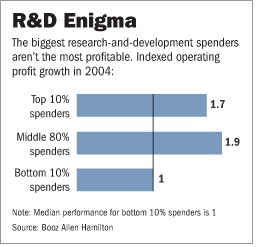
(Source: downloaded graphic from online version of WSJ see below, p. A13)
Booz Allen Hamilton Inc., a consulting firm, analyzed six years of financial results by 1,000 publicly traded companies responsible for the bulk of R&D spending globally. The firm found the companies that spent proportionately greater sums than their industry peers didn’t enjoy greater revenue gains or better profits.
The finding flies in the face of academic studies and accepted wisdom on the value of corporate research. It also comes as researchers warn that U.S. companies need to increase spending or risk falling behind rivals in China and India, which are rapidly industrializing.
Booz Allen concluded that once a minimum level of research and development spending is achieved, better oversight and culture were more significant factors in determining financial results. The study calculated the percentage of a company’s revenue spent on R&D and compared it with sales growth, gross profit, operating profit, market capitalization and total shareholder result.
McWilliams, Gary. “In R&D, Brains Beat Spending In Boosting Profit.” The Wall Street Journal
(Weds., October 11, 2005): A2 & A13.
Ah, so maybe the entrepreneur or R&D manager, can make a difference after all? (This is not a surprise, if you believe, as I do, that Clayton Christensen is on to something important.) Or, though less interesting, the results might just be due to diminishing returns to R&D.

 Source of book image: http://www.mikemilken.com/fincareer.taf?page=they_made_america
Source of book image: http://www.mikemilken.com/fincareer.taf?page=they_made_america 
